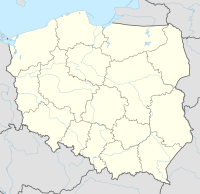Kraków barbican
| Kraków Barbican | |
|---|---|
| Barbakan krakowski | |
| Kraków | |

Kraków Barbican, seen from Basztowa Street. Left: section of covered passageway leading to St. Florian's Gate at the city walls.
|
|
| Coordinates | 50°03′56″N 19°56′30″E / 50.065472°N 19.941661°E |
| Type | Polish Gothic outpost |
| Site history | |
| Built | 1498 |
The Kraków Barbican (Polish: barbakan krakowski) is a barbican – a fortified outpost once connected to the city walls. It is a historic gateway leading into the Old Town of Kraków, Poland. The barbican is one of the few remaining relics of the complex network of fortifications and defensive barriers that once encircled the royal city of Kraków in the south of Poland. It currently serves as a tourist attraction and venue for a variety of exhibitions.
The Gothic-style barbican, built around 1498, is one of only three such fortified outposts still surviving in Europe, and the best preserved. It is a moated cylindrical brick structure with an inner courtyard 24.4 meters in diameter, and seven turrets. Its 3-meter-thick walls hold 130 embrasures. The barbican was originally linked to the city walls by a covered passageway that led through St. Florian's Gate and served as a checkpoint for all who entered the city.
Considered a masterpiece of medieval military engineering, the circular fortress of the Kraków's Barbakan was added to the city's fortifications along the coronation route in the late 15th century, based on Arabic rather than European defensive strategy. On its eastern wall, a tablet commemorates the feat of a Kraków , Marcin Oracewicz, who, during the Bar Confederation, defended the town against the Russians and shot their Colonel Panin.
Kraków Barbican in the 1930s
Gate to the former fortified passage facing St. Florian's Gate to the south
Kraków Barbican modern entrance
Barbican's defensive walls and the connecting bridge from before their 19th century dismantlement
...
Wikipedia

